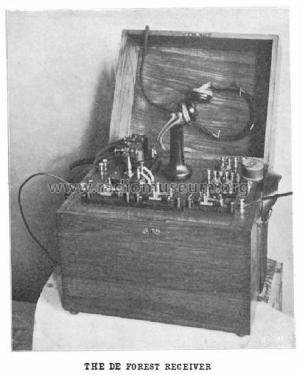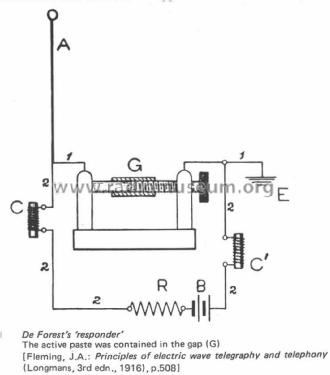Electrolytic Anti-Coherer DeForest-Smythe
DeForest Radio Telephone & Telegraph Co. (De Forest); New York
- País
- Estados Unidos
- Fabricante / Marca
- DeForest Radio Telephone & Telegraph Co. (De Forest); New York
- Año
- 1899–1901 ?
- Categoría
- Módulo de radio de antes de 1926 (ni parte ni manipulador)
- Radiomuseum.org ID
- 278969
-
- alternative name: Lee De Forest Mfg.
- Principio principal
- Diseños especiales
- Gama de ondas
- - no hay
- Tensión de funcionamiento
- Baterías recargables o pilas
- Altavoz
- - Este modelo usa amplificador externo de B.F.
- Material
- Materiales diversos
- de Radiomuseum.org
- Modelo: Electrolytic Anti-Coherer [DeForest-Smythe] - DeForest Radio Telephone &
- Forma
- Sobremesa de cualquier forma, detalles no conocidos.
- Anotaciones
-
In late 1900, along with W.W. Smythe, de Forest took out a patent for adetector, and called it “the Electrolytic Anti-Coherer.”This detector was constructed like the filing coherer used by Marconi. There were two metal plugs contained in an insulated tube with a gap of about 1/100 inch between them. The gap was filled with one of several mixtures the inventors refered to as "goo". A typical mixture consisted of lead oxide, glycerine, water and metal fillings. The fillings were intended to act as secondary electrodes within the gap. Under the influence of a locally applied direct voltage crystalline lead is produced in such a paste and this builds up into chains and trees across the gap, like the silver particles in Schafer's plate. When a chain is completed deposition ceases as the gap is effectively short circuited. Once again a received pulse of oscillations breaks the chain causing a click to be heard in the telephone receiver which may be connected in the battery circuit.
- Mencionado en
- Western Electrician, July 27, 1901, pages 49-50
- Autor
- Modelo creado por Alan Larsen. Ver en "Modificar Ficha" los participantes posteriores.
- Otros modelos
-
Donde encontrará 158 modelos, 133 con imágenes y 16 con esquemas.
Ir al listado general de DeForest Radio Telephone & Telegraph Co. (De Forest); New York

